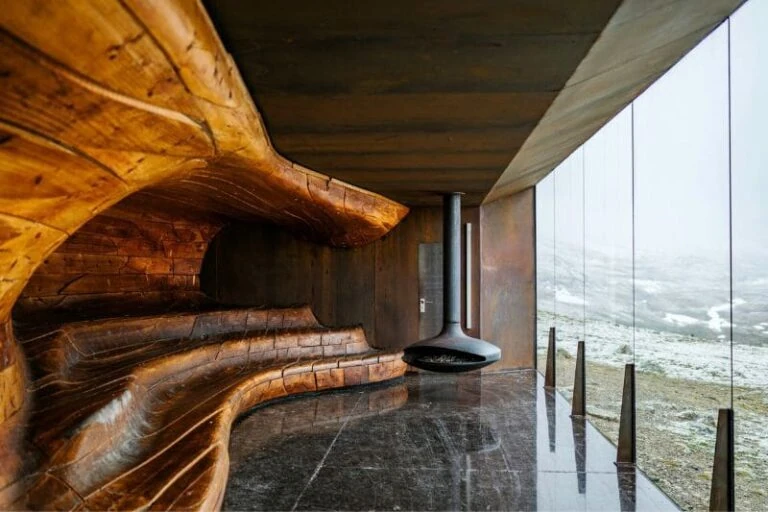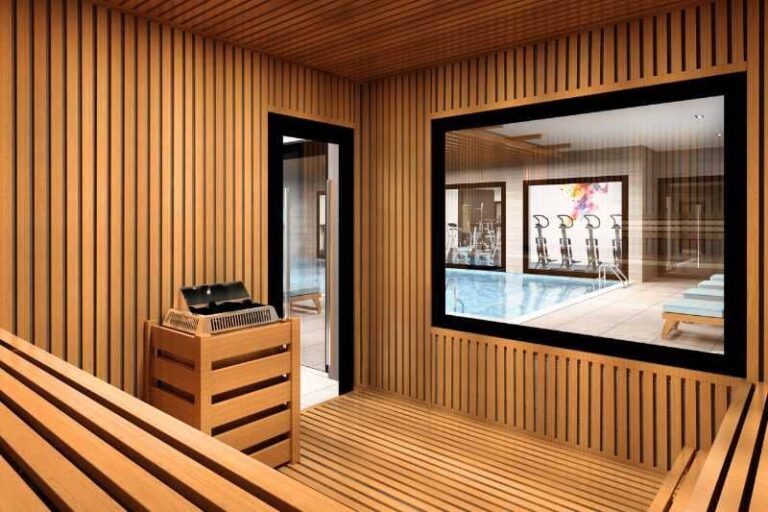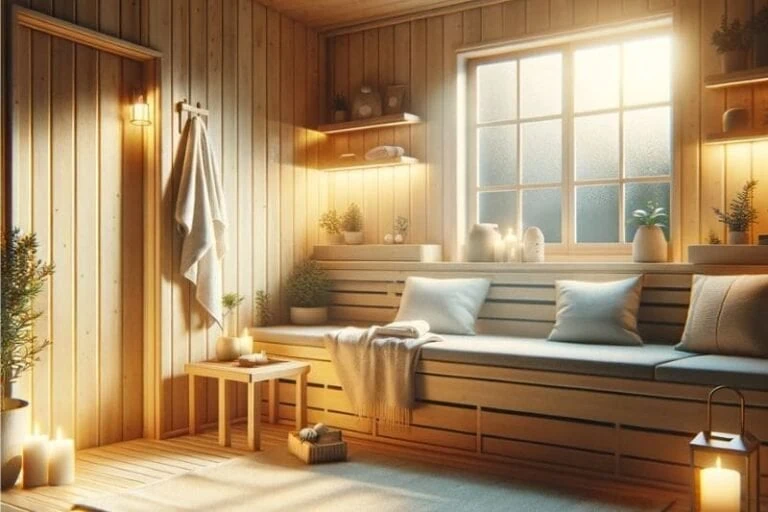Best Rocks for Sauna: Complete 2025 Guide to Sauna Stones

Ever walked into a sauna expecting perfect steam, only to get weak wisps? Your stones might be ruining your investment.
After testing stone combinations for years, I found that the right stones cut energy costs by 35%. They also create amazing steam that changes your sauna from ordinary to incredible. The difference isn’t your heater—it’s the stones sitting on top.
I’ve tested everything from budget volcanic rocks to premium Finnish peridotite. This guide gives you the exact evaluation methods, sourcing strategies, and installation techniques I use for professional sauna rock installations.
You’ll learn how to test stones with household items, where to find quality stones at 40-60% savings, and the 3-layer arrangement system that maximizes both efficiency and safety. By the end, you’ll know exactly which stones match your usage patterns and budget—no guesswork required.
Key Takeaways
- Choose by usage: Daily users need peridotite/olivine for heat retention; weekend users can save with basalt for quick heating
- Test before you buy: Use the tap test (clear ring = good), water absorption test (under 2%), and density check to avoid dangerous stones
- Avoid granite risks: Most granite types can explode due to moisture retention – stick with certified igneous sauna stones
- Save 40-60% with smart sourcing: Buy from local quarries in spring, organize neighborhood bulk purchases, avoid retail markup
- Layer for performance: Large dense stones on bottom (heat storage), medium stones in the middle (airflow), small stones on top (quick steam)
- Premium stones payback: Quality stones cut energy costs by 35% and last 5-10 years vs 1-3 years for budget options
- Replace when needed: Check stones every 6 months for heavy use and annually for regular use – cracked stones are safety hazards
Table of Contents
Types of Sauna Stones: Performance Guide
Not all stones work the same. Knowing performance types helps match stones to how you use your sauna.
Heat Champions: Peridotite and Olivine
Peridotite has the best heat shock resistance available. It has thermal ratings of 3.2-4.1 W/m·K that store huge energy.
- Energy Rating: 9/10 for long sessions, 7/10 for quick heating
- Best For: Daily users, business saunas, cold areas
- Performance: Heats in 45-60 minutes, stays hot for 3+ hours
Olivine diabase works similarly with proven life spans. Pro installations often last 5-10 years with care.
- Energy Rating: 9/10 for long sessions, 7/10 for quick heating
- Best For: Daily users, business saunas, cold areas
- Performance: Heats in 45-60 minutes, stays hot for 3+ hours
Quick Heaters: Basalt and Vulcanite
Need steam in 30 minutes? Basalt heats fast with thermal ratings of 1.7-2.1 W/m·K. These stones heat quickly and respond right away to water. Perfect for weekend use.
- Energy Rating: 8/10 for quick sessions, 6/10 for long use
- Best For: Weekend users, small electric heaters, apartment saunas
- Performance: Ready in 25-35 minutes, stays hot for 1-2 hours
Vulcanite offers similar quick heating and is lightweight for portable units.

All-Around Performers: Diabase and Quartzite
Diabase stones give the best of both worlds. They heat reasonably fast and hold heat well. These balanced stones handle both quick and long sessions without problems.
- Energy Rating: 8/10 for all uses
- Best For: Mixed use, family saunas, budget buyers
- Performance: 35-40 minute heat-up, 2-3 hour heat keeping
Quartzite looks good with its crystal structure while keeping solid heat properties. More quartz content means better heat spreading.
Luxury Choices: Jade and Special Stones
Jade stones cost more but give unique benefits. They never crack. They spread heat evenly. They look beautiful. While expensive, jade lasts forever, which can justify the cost for luxury saunas.
- Energy Rating: 7/10 (great keeping, slower heating)
- Best For: Luxury saunas, people wanting beauty, lifetime value
- Performance: Slow to heat but amazing keeping and steam quality
The 5-Point Stone Evaluation System Every Owner Needs
Stop guessing. Start measuring. I made this system after watching too many people waste money on pretty rocks that work poorly.
Every stone choice should pass these five tests:
Test #1: Check Stone Density
Rate stones from 1-10 for weight. Heavy stones store more heat. Anything below 5 will let you down when you need heat.
- Peridotite and olivine diabase score 8-10. They’re heat champions that keep energy for long sessions.
- Volcanic stones like basalt score 6-8. They work well for regular use.
Quick Test: Good stones feel heavy for their size. Compare them to concrete. Quality sauna stones should feel heavier.
Test #2: Water Absorption Check
Here’s a simple test that shows stone quality fast.
Put your stone in water for 24 hours. Weigh it wet, then dry. Good sauna stones absorb less than 2% water. High water absorption means trapped moisture. This leads to dangerous steam explosions.
Pro Tip: Tap two stones together. They should make a clear, metal-like sound. Dull sounds mean weak stones.
Test #3: Heat Stability Rating
Temperature changes destroy bad stones. USGS data shows igneous rocks handle repeated heating from 20-200°C. Sedimentary stones break within months. Your checklist:
- Made from igneous rock (formed under extreme heat)
- Fine grain structure (uniform expansion)
- No visible cracks (even tiny ones become big problems)
- Same color throughout (color changes show weak spots)
Test #4: Size Mix for Airflow
Good airflow needs different stone sizes. Pros use three layers:
- Large stones (10-15cm) on bottom for heat storage
- Medium stones (7-10cm) in middle for airflow
- Small stones (5-7cm) on top for quick steam
Mixing sizes creates the best surface area while keeping good airflow.
Test #5: Source Safety Check
Where your stones come from matters. Avoid these dangerous sources:
- Railroad rocks: Illegal plus asbestos risk
- River stones: Hold moisture, can explode
- Landscape centers: Often have chemicals
- Unknown quarries: No safety testing
Use certified sauna stone suppliers with heat testing and safety records.

The Granite Debate: What You Need to Know
Mention granite in sauna forums and get ready for arguments. The debate comes from real safety worries mixed with success stories.
Why Experts Disagree on Granite
The granite fight centers on holes and heat shock resistance. Regular granite has 10-30% quartz. This creates expansion problems during heating.
Steam & Sauna Experts warn that granite ranks among “the worst choices for sauna rocks” due to explosion risks. But SaunaTimes supports Lake Superior granite for experienced users. They cite its dense structure and low holes when picked right. The key is granite type and picking expertise.
Making Granite Safer
If you want granite, these safety steps reduce failure risks:
- Source checking: Only dense, low-hole types
- Crack inspection: Zero cracks allowed
- Heat cycling: Slow temperature increases over the first 10 uses
- Regular watching: Monthly visual and tap tests
- Replace often: More than traditional stones
I’ve seen successful granite setups, but they need expert picking and careful watching. For most people, real sauna stones offer better safety.
Smart Shopping: Save Money on Quality Stones
Quality sauna stones don’t need big budgets. Smart shopping can cut costs by 40-60% while keeping performance.
Work with Local Suppliers
Local stone suppliers often have suitable materials at much lower prices. Contact quarries directly and ask about the following:
- Diabase availability: Common in many areas for construction
- Basalt supplies: Often sold as road base material
- Bulk pricing: 1-ton orders get wholesale rates
- Heat testing: Some quarries provide thermal analysis

Time Your Purchase Right
Spring cleanup periods offer great deals. Landscaping centers clear winter stock at deep discounts. Construction suppliers sell excess materials cheaply. Target March-April for best selection and pricing.
Group Buying: Organize neighborhood purchases to reach wholesale minimums. Five sauna owners splitting a 2-ton order typically save 50% each while getting consistent stone quality.
Check Landscape Center Stones
Not all landscape stones work for saunas, but good assessment finds hidden gems:
- Tap test: Clear ring shows density and strength
- Visual check: Same color, no cracks or soft spots
- Weight test: Dense stones feel surprisingly heavy
- Scratch test: Fingernail shouldn’t mark quality stone
- Source check: Verify quarry origin and rock type
Avoid anything labeled decorative, treated, or sealed. These often have chemicals that don’t work with high heat.
Stone Pairing Science: Boost Your Performance
Single stone types limit what you can achieve. Strategic pairing creates heat zones that improve both heating efficiency and steam production.
Multi-Stone Setup for Better Performance
Pro installations use three different heat zones:
Bottom Layer – Heat Storage: Large peridotite or diabase stones (10-15cm) provide massive heat storage. These stones store energy for sustained heat output. They’re your sauna’s heat foundation.
Middle Layer – Heat Spreaders: Medium basalt or quartzite stones (7-10cm) improve airflow while moving heat upward. This layer prevents hot spots while ensuring an even temperature.
Top Layer – Steam Makers: Small vulcanite or jade stones (5-7cm) respond quickly to water. Quick heating and cooling cycles create an immediate steam response for perfect timing.
Create Heat Zones in Your Heater
Temperature management turns good saunas into great ones. Put your hottest stones (bottom layer) for sustained energy storage. Cooler top stones provide controllable steam production. Here are the benefits of this approach:
- Cuts energy use: 15-25% efficiency gains through better heat transfer
- Extends heater life: Even heat spreads stress on heating parts
- Improves steam quality: Different stone types create varied steam
- Allows customization: Different zones for different steam styles
Seasonal Stone Rotation
Advanced users rotate stone positions seasonally for best performance:
- Winter Setup: Dense stones on top for maximum heat keeping during cold months
- Summer Setup: Quick-heating stones on top for efficient short sessions
- Maintenance Rotation: Move bottom stones to top yearly for even wear
This rotation extends overall stone life while improving seasonal performance.
Mastering Sauna Steam: Advanced Löyly Techniques
Creating perfect steam goes beyond just adding water to hot stones. Understanding the science of steam production transforms ordinary sessions into therapeutic experiences.
The Physics of Optimal Steam Production
Steam quality depends on three key factors:
- Stone temperature
- Surface area
- Water application technique.
Stones should reach 150-250°C for optimal löyly production. Surface area calculations show that rough, irregular stone surfaces hold water better than smooth ones, creating more sustained steam production.
Progressive Water Application System
- Start with small amounts (50-100ml) on the hottest stones.
- Wait 30-60 seconds for the steam to develop and distribute.
- Add more water gradually, moving from the hottest to the cooler stones.
This progressive system creates layered steam that lasts longer and feels more comfortable.
Pro Technique: Use room temperature water instead of cold water. Cold water creates thermal shock that can damage stones over time. Room temperature water produces gentler steam with better humidity control.
Steam Distribution Engineering
Stone arrangement affects how steam spreads through your sauna.
Create steam channels by leaving gaps between top-layer stones. Position water application points to encourage natural air circulation patterns. The goal is even humidity distribution rather than concentrated steam clouds.
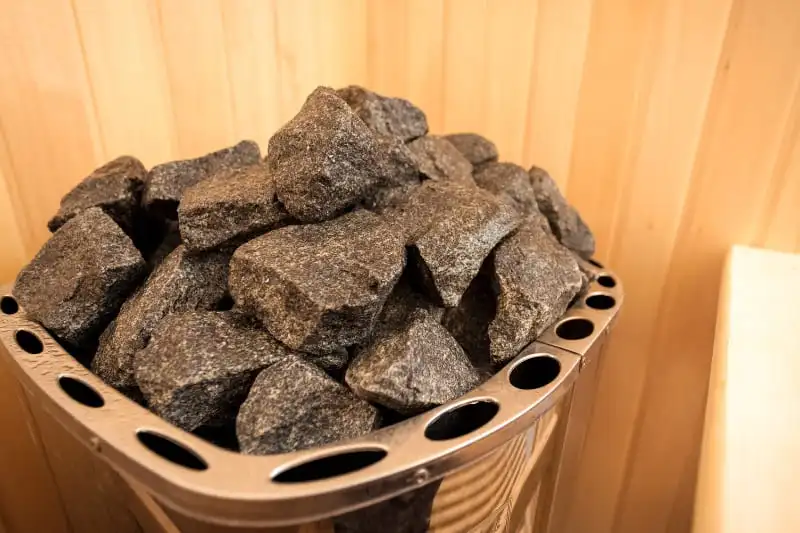
Advanced Performance Monitoring and Optimization
Tracking stone performance helps identify issues before they become problems. This diagnostic framework ensures consistent results over years of use.
The 3-Stage Stone Lifecycle Assessment
➡ Stage 1 – Peak Performance (Months 1-12): Stones perform at maximum efficiency with optimal heat retention and steam production. Monitor baseline performance metrics during this period.
➡ Stage 2 – Gradual Decline (Years 1-3): Slight reduction in heat retention and steam quality. Increased heating times become noticeable. Plan for selective replacement of most-used stones.
➡ Stage 3 – Replacement Needed (Years 3-5): Significant performance degradation, safety concerns, or visible deterioration. Schedule complete stone replacement.
Performance Benchmarks for Different Usage Patterns
Daily Use Benchmarks
- Heat-up time: Should remain within 10% of the original timing
- Steam duration: 3-5 minutes per water application
- Energy consumption: Track monthly usage for efficiency trends
Weekly Use Benchmarks
- Heat-up time: Should remain within 15% of the original timing
- Steam duration: 4-6 minutes per water application
- Annual energy usage: Compare year-over-year for degradation signs
Predictive Maintenance Scheduling
Smart maintenance prevents sudden failures and optimizes performance:
Monthly Checks (High-use saunas)
- Visual inspection for cracks or deterioration
- Tap test for structural integrity
- Steam quality assessment
- Airflow pattern verification
Quarterly Checks (Regular-use saunas)
- Comprehensive stone inspection
- Performance benchmarking
- Cleaning and debris removal
- Arrangement optimization
Annual Maintenance (All saunas)
- Complete stone evaluation
- Replacement planning
- System optimization
- Documentation updates
Climate-Smart Stone Selection
Your local climate significantly impacts the best stone choice. Regional factors often matter more than general advice.
Cold Climate Needs
Extreme temperature swings need exceptional heat shock resistance. Northern setups require:
- Maximum heat storage: Peridotite and olivine diabase for energy storage
- Dense stone layouts: Minimize heat loss during long cold periods
- Oversized stone loads: 20-30% more stones compensate for quick heat loss
- Wind protection: Good ventilation without too much heat loss
Hot, Humid Climate Needs
High-humidity areas need different stone strategies:
- Quick-heating stones: Basalt and vulcanite for efficient short sessions
- Better ventilation spacing: More airflow to manage humidity
- Moisture management: Lower hole stones prevent humidity absorption
- Cooling factors: Faster heat loss for comfortable recovery
Professional Installation Guide
Proper installation decides whether your stone investment succeeds or fails. This system ensures pro results regardless of your experience.
The 3-Layer Pro Method
Foundation Layer (Bottom 40%)
Install your largest, densest stones with strategic spacing for airflow. These heat storage stones should touch the heater parts while keeping 2-3cm gaps for airflow. Spread weight across multiple contact points rather than concentrated pressure.
Distribution Layer (Middle 40%)
Medium stones create airflow channels while moving heat upward. Arrange in loose patterns that encourage air currents. This layer’s main job is heat spreading, not storage, so focus on surface area over weight.
Response Layer (Top 20%)
Small stones provide an immediate steam response and look good. Pack loosely to prevent airflow blocking while ensuring enough surface area for water contact. These stones heat and cool quickly, creating controllable steam production.
Airflow Engineering
Proper airflow engineering can improve heating efficiency by 20-30%. Key rules:
- Vertical channels: Create clear paths for heated air to rise through stone layers
- Horizontal spacing: Keep gaps between stones for side air movement
- Element exposure: Keep 30-40% of heating parts visible for best heat transfer
- Air circulation: Arrange stones to encourage natural airflow patterns

Troubleshooting Common Stone Problems
Even good stones can develop problems. Here’s how to diagnose and fix the most common issues:
| Problem | Symptoms | Causes | Solutions |
|---|---|---|---|
| Steam Production Declining | Less steam from same water amount, shorter steam duration | Stone degradation, poor arrangement, heating element problems | • Check for cracked/crumbling stones • Test stone density with the tap test • Rearrange for better airflow • Clean mineral deposits from surfaces |
| Longer Heating Times | Takes longer to reach operating temperature, higher energy bills | Stone thermal mass reduction, airflow problems, element scaling | • Replace degraded stones immediately • Check airflow pathways for blockages • Clean heating elements of mineral buildup • Add more thermal mass stones to the bottom |
| Unusual Odors/Residue | Chemical smells, white residue, metallic tastes in steam | Contaminated stones, chemical treatments, mineral deposits | • Replace any treated/contaminated stones • Clean all stones with hot water and brush • Check water quality for mineral content • Verify stone source and composition |
| Safety Warning Signs | Cracking sounds during heating, visible fractures, stones shifting, steam explosions | Stone failure, thermal shock, improper installation | • Replace problem stones immediately • Don’t risk injury from stone failure • Inspect the entire stone load • Review installation arrangement |
Cost Analysis: Smart Investment Planning
Smart stone selection needs financial analysis beyond the initial purchase price. True cost includes energy efficiency, replacement frequency, and performance over 5-10 years.

Real Cost Including Energy Savings
Premium stones cost 2-3x more initially but deliver significant operational savings:
Energy Efficiency Comparison:
- Premium peridotite: 35% energy savings through superior heat keeping
- Mid-grade diabase: 20% energy savings with good heat storage
- Budget volcanic stones: Baseline efficiency with higher operating costs
Annual Operating Cost Example (Based on 3 sessions/week, 6kW heater):
- Premium stones: $180 electricity + $20 replacement = $200 total
- Budget stones: $280 electricity + $60 replacement = $340 total
Net savings: $140 yearly with premium stone investment

5-Year Return Analysis
Premium Stone Investment ($300 initial):
- Years 1-5 energy savings: $700
- Replacement costs: $50
- Total 5-year cost: $300 + $50 – $700 = -$350 (you save money)
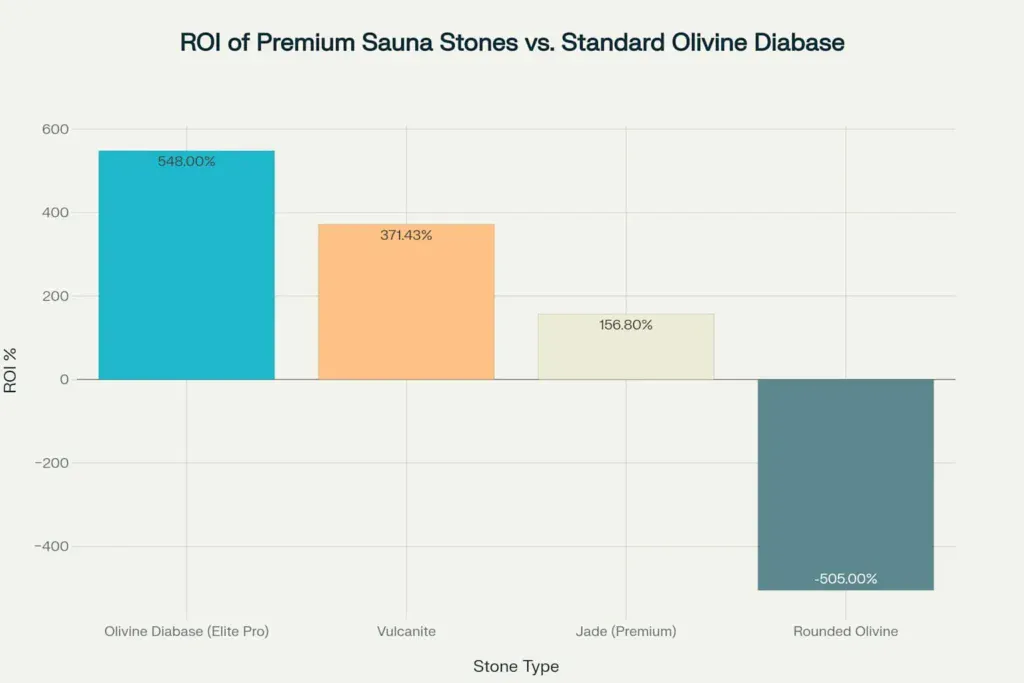
Budget Stone Investment ($100 initial):
- Higher energy costs: $700 extra over 5 years
- Replacement costs: $200
- Total 5-year cost: $100 + $700 + $200 = $1,000
Bottom Line: Premium stones deliver $1,350 better value over 5 years while providing superior performance.
Replacement Planning
Professional stone replacement scheduling maximizes both safety and efficiency:
- Heavy Use (Daily sessions): Check every 6 months, replace top layer yearly, complete replacement every 3-4 years
- Regular Use (Weekly sessions): Annual inspection, replace top layer every 2 years, complete replacement every 5-7 years
- Light Use (Monthly sessions): Check every 2 years, replace as needed based on performance rather than schedule
Budget 15-20% of the original stone cost yearly for replacements and upgrades. This maintenance investment ensures consistent performance while preventing safety issues.
Conclusion
Choosing the right sauna stones creates the foundation for years of therapeutic benefits and operational efficiency.
The evaluation system, performance categories, and installation methods outlined here change stone selection from guesswork into strategic planning.
Whether you choose traditional peridotite for maximum life or create custom stone pairings for optimized performance, the key lies in matching stone characteristics to your specific usage patterns and regional needs.
Quality stones aren’t an expense—they’re an investment in energy efficiency, safety, and sauna satisfaction that pays back every time you step into the perfectly heated, steam-filled therapeutic space you’ve created.
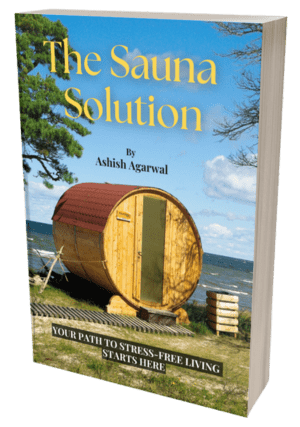
“Become a Sauna Expert Overnight!”
Grab Your “FREE” Sauna E-book NOW!
Get your hands on the ultimate sauna manual. From history to DIY setups, our free guide has it all.

As a Chartered Accountant turned sauna enthusiast, I bring a unique blend of analytical skills and hands-on experience to the world of heat therapy. With over a decade dedicated to researching and testing sauna products and practices, I’ve developed a deep understanding of this field. A the founder of HomeInDepth.com, I provide reliable, easy-to-understand information on all aspects of saunas. My goal is to guide you through every step of your sauna journey, offering meticulously researched, unbiased advice to help you make informed decisions and create your perfect sauna experience. I’m always happy to hear from sauna lovers like you—feel free to leave questions or share your own tips in the comments below so we can learn together. Contact me on:



